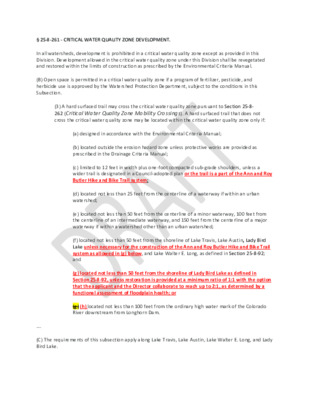03-2: Butler Trail Code Amendment Redline — original pdf
Backup

…. § 25-8-261 - CRITICAL WATER QUALITY ZONE DEVELOPMENT. In all watersheds, development is prohibited in a critical water quality zone except as provided in this Division. Development allowed in the critical water quality zone under this Division shall be revegetated and restored within the limits of construction as prescribed by the Environmental Criteria Manual. (B) Open space is permitted in a critical water quality zone if a program of fertilizer, pesticide, and herbicide use is approved by the Watershed Protection Department, subject to the conditions in this Subsection. (3) A hard surfaced trail may cross the critical water quality zone pursuant to Section 25-8- 262 (Critical Water Quality Zone Mobility Crossings). A hard surfaced trail that does not cross the critical water quality zone may be located within the critical water quality zone only if: (a) designed in accordance with the Environmental Criteria Manual; (b) located outside the erosion hazard zone unless protective works are provided as prescribed in the Drainage Criteria Manual; (c) limited to 12 feet in width plus one-foot compacted sub-grade shoulders, unless a wider trail is designated in a Council-adopted plan or the trail is a part of the Ann and Roy Butler Hike and Bike Trail system; (d) located not less than 25 feet from the centerline of a waterway if within an urban watershed; (e) located not less than 50 feet from the centerline of a minor waterway, 100 feet from the centerline of an intermediate waterway, and 150 feet from the centerline of a major waterway if within a watershed other than an urban watershed; (f) located not less than 50 feet from the shoreline of Lake Travis, Lake Austin, Lady Bird Lake unless necessary for the construction of the Ann and Roy Butler Hike and Bike Trail system as allowed in (g) below, and Lake Walter E. Long, as defined in Section 25-8-92; and (g) located not less than 50 feet from the shoreline of Lady Bird Lake as defined in Section 25-8-92, unless restoration is provided at a minimum ratio of 1:1 with the option that the applicant and the Director collaborate to reach up to 2:1, as determined by a functional assessment of floodplain health; or (g) (h) located not less than 100 feet from the ordinary high water mark of the Colorado River downstream from Longhorn Dam. (C) The requirements of this subsection apply along Lake Travis, Lake Austin, Lake Walter E. Long, and Lady Bird Lake. (1) A dock, public boat ramp, bulkhead or marina, and necessary access and appurtenances, are permitted in a critical water quality zone subject to compliance with Chapter 25-2, Subchapter C, Article 12 (Docks, Bulkheads, and Shoreline Access). For a single-family residential use, necessary access may not exceed the minimum area of land disturbance required to construct a single means of access from the shoreline to a dock. (2) Disturbed areas not associated with the Ann and Roy Butler Hike and Bike Trail System must be restored in accordance with the Environmental Criteria Manual and the following requirements: (a) Within a lakefront critical water quality zone, or an equivalent area within 25 feet of a shoreline, restoration must include: (i) at least one native shade tree and one native understory tree, per 500 square feet of disturbed area; and (ii) one native shrub per 150 square feet of disturbed area; and (b) Remaining disturbed areas must be restored per standard specifications for native restoration.